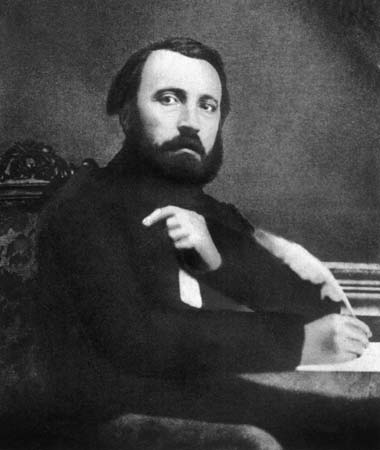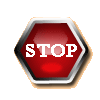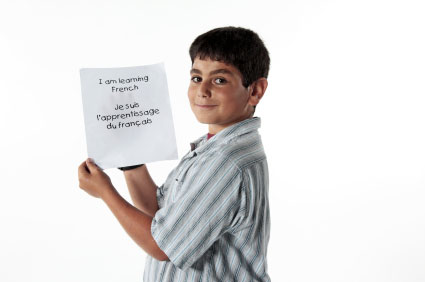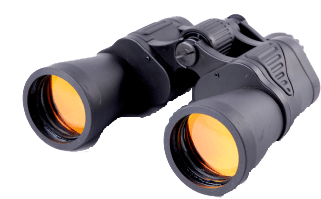NOUNS: GENDER, ARTICLES, PLURALS,
PRONUNCIATION OF THE LETTER E,
AND USE OF THE FRENCH-ENGLISH DICTIONARY
Pierre Larousse
a founder of the Larousse dictionary
UNIT OVERVIEW
In this unit, the student will learn about French nouns: their gender, articles, and plurals; the use of a French-English dictionary; the pronunciation of the letter "e"; the concept of imports from Francophone countries; and the names of French-speaking countries.
ÉPREUVE
This section challenges your French knowledge and lets you reflect on what you have learned in previous units by answering a series of questions. How do you think you will score?
Now answer questions 1-5.
SITUATION
You want to know if the school has a computer for you to use. You ask Yves.
Voilà l’ordinateur. There is the computer!
OBSERVATION
Look around you. You probably can name at least 10 nouns from just where you are. Remember: a noun is a person, place, thing, or idea. Here is a list of nouns you might name:
le clavier the keyboard le professeur the teacher la leçon the lesson la question the question le mot the word la phrase the sentence la salle de classe the classroom
Now answer question 6-11.
LES MODES DE CONVERSATION ET DE GRAMMAIRE
€ Every noun in French is either masculine or feminine.
It has nothing to do with what they look like, or who owns them. It is simply a matter of grammar. In French, the masculine word for ‘the’ is le. The feminine word for ‘the’ is la. Masculine and feminine refer to the gender of the noun. This is simply a grammar term.
The l’ is like our English contractions. In French, if the noun starts with a vowel or vowel sound, the word for "the" becomes l’. The contraction is mandatory. It is not like English, where contractions are optional. (You could write "it is" or "it's") The making of a contraction is called élision. There will be other examples of élision as you continue the course.€ The word ‘the’ is called the definite article, l’article défini.
Now answer question 12-17.
When you learn a noun, you should learn the definite article with it so that you can remember its gender.
If you don’t remember the gender of a noun, here are some hints for making good guesses about whether the noun is masculine or feminine. If the word ends in –eur, it is probably masculine. If the word ends in –tion, it is feminine. For any other word, you must memorize its gender.
Some words can be either feminine or masculine, depending on who or what they refer to:
Modèle: le livre the book Modèle: la livre the pound As you progress in French, you will learn other endings that will give a hint to the gender.
Click on the button below to test your knowledge of definite articles in French. (Note: you may want to turn off your pop-up blocker. The quiz will come up in a new window.)€ There is another type of article: l’article indéfini (indefinite article). In English, this is the word a or an. In French, there are two forms: un and une. Un is for masculine nouns. Une is for feminine nouns.
Modèle: le livre the book Modèle: la leçon the lesson Modèle: un livre a book Modèle:une leçon a lesson
€ Nouns are usually made plural by adding "–s." Even if the word adds "–es" in English, just add "–s" in French. Since the final vowel is usually silent, the –s is usually also silent. Words that end in "–s", "- x", or "-z", like souris, add nothing to the noun to make them plural.
Singular Plural Professeur Professeurs Match Matchs Bus Bus € When a word is plural, the definite article must also be plural. The plural form of the definite article is always les. It does not matter if the word is masculine, feminine, or begins with a vowel.
Modèle:
le livre la souris l’étudiant
Masculine Feminine Vowel
Now answer question 18-27.
PRONONCIATION
SyllablesThe French language is more easily pronounced when you consider the syllables of a word, rather than every letter. Divide the word into syllables, then with the rules in these units, you will be able to pronounce every word with just a little practice. The rules of syllabication are given here.
1. Each syllable has a vowel or group of vowels. Beau has only one syllable, although there are three vowels. Its syllable pattern is CV. "B" is the consonant, followed by vowels. This is called an open syllable because it ends in a vowel sound.2. The word bec also has only one syllable. Its syllable pattern is CVC. This is called a closed syllable because it ends in a consonant sound.
3. If a syllable ends in a consonant that is not pronounced, as in the word riz, the syllable is called an open syllable.
4.Some syllables might have only a vowel in them. This pattern is V. It is of course an open syllable because there is no consonant sound at the end of the syllable.
“So what? Who cares?” you might be saying to yourself. YOU should care.In English, if a person does not pronounce things right, the conversation stops. Pronunciation matters. Learning the rules will help you figure out the pronunciation of a word you might find in a French dictionary.
La lettre ‘e’ in an open syllable.The letter "e," when alone in an open syllable (that is, not with other vowels), is pronounced like the "–e "in the English word "the", but just a little bit tighter. That means your mouth should be more closed as you say the "e".
Practice saying "the" with your mouth very open, and then closed more. When your mouth is more closed, you will have the correct sound. Some people call this the schwa sound. Some French dialects pronounce every "e," even at the end of the word. We are going to pronounce every syllable for a few units, so we will follow this practice. In our phonetic spelling, we are going to write [uh] to represent this sound.
Remember: letters in [ ] refer to the pronunciation of a word, not the spelling.
Modèle: madame [mah-DA-muh]
Practice these words. Say them aloud. Don’t be shy!le [luh] regard [ruh-GAHR] demande [duh MAH(n) Duh]
€ Have you wondered why there are parentheses around the letter (n) in many words? This means that the n is not clearly pronounced; it is nasalized. Say it through your nose. It is easy to do if you keep your mouth open and tongue down. Say the word down. Notice where your tongue is at the end of the word. Now say the word down without putting your tongue on the roof of your mouth. Keep your mouth open. That is how to nasalize the n.
The Language Guide is a website where you can find vocabulary words in different categories. In addition, if you download the correct media player, you can hear the correct French pronunciation of the vocabulary words. The page is available to view in PDF form as well.
Now answer question 28-31.
DE PLUS EN PLUS
Le dictionnaireNow that you are in French I, you will want to use a dictionary to help you find what you want to say. This should help you to use the dictionary effectively and say what you really want to say!
The first thing to notice in most book-style French-English dictionaries is that it is divided into two parts. One half will be translation from English to French. The other half will be translation from French to English. Both sides are in alphabetical order. French uses the Roman alphabet, the same one we use in English.
Now answer question 32.
To look up a word in the dictionary, you need to know how the word is used in the sentence. Is it a noun, a verb, a conjunction? That makes a big difference in which word you will choose.
Modèle: I want to play soccer
Modèle: I want to go to the play.
When you find your word, choose the meaning that is the same part of speech. Some dictionaries use different abbreviations than you might be used to. For example, 's'. means that the dictionary is giving the definitions for a noun. That, 's.' stands for substantive, another word for noun.
Now answer question 33.
Once you have chosen the correct part of speech, the dictionary still might have more words to choose from. Then you must decide what the true meaning of the word you are looking up is.
Modèle: I want to see the play. (drama, show) Some dictionaries have helps with each definition. They might give a model sentence, or tell the category that the word belongs to: i.e. music.
A colon (;) indicates a different meaning of the entry word.
A dash (---- ) in a bold print expression indicates where the entry word is placed in an expression.If you still can’t decide, choose a synonym of what you want to look up. It might be easier. To double-check your translation, use the dictionary to reverse-translate the French into English.
LA CULTURE ET LES CONNECTIONS
French countries offer many goods to the world. However, many people don’t realize how diverse and extensive the Francophone world is. Of course, we think of France and parts of Canada as French speaking areas, but there are many more.
LE FRANÇAIS EN ANGLAIS
A common French term used in English is à la mode. We now mean a dessert served with ice cream on top. The phrase à la mode literally means in style. Some chef somewhere must have convinced his French clientèle that this was the best way to have dessert.
LA GÉOGRAPHIE
You can literally travel around the world and use French. The following areas have French as an official or prominent language:North America —United States (Louisiana, Wisconsin, and New England), Canada, St. Pierre et Miquelon Islands (near Canada).
South America and Caribbean—Dominica (called Dominique in France), Guadeloupe (a département of France—like a state), Haiti, St. Lucia (called St. Lucie in France), Martinique (another département), St. Bartholémy, Guyana (called Guyane in France—another département).
Europe—Andorra (Andorre), France, Belgium (Belgique), Jersey Island, Luxembourg, Switzerland (la Suisse), Monaco, Italy (Val d’Aoste).
Africa —Algeria (Algérie), Benin, Burkina Faso, Burundi, Cameroon (Caméroun), Central African Republic (Centrafrique), Congo, Djibouti, Égypte, Ivory Coast (Côte d’Ivoire,) Gabon, Guinea (Guinée), Mali, Maroc, Mauritania (Mauritanée), Niger, Rwanda, Senegal (Sénégal), Chad (Tchad), Togo, Tunisia (Tunisie), Democratic Republic of Congo.
Asia and Middle East—Lebanon (Liban), Syria (Syrie), India (Inde—especially Pondichéry province), Cambodia (Cambodge), Laos, Vietnam.
South Indian Ocean—Camoro Islands (Camores), Madagascar, Mauritius (Ile Maurice), Mayotte, Reunion Island (Réunion—departement), Seychelle Islands (Seychelles).
Pacific Ocean—French Polynesia (Polynésie, including Tahiti), New Caledonia (Nouvelle Calédonie), Wallis and Futuna (Wallis et Futuna), Vanuatu.
Now answer question 34-37.
CHEZ VOUS
Label the things you know in French. This will help you and might teach your family a few things, too! You can become the resident expert, as they see little signs hanging around.
RÉVISION
In each unit, you should learn all the French words presented. You should also review all the presentations that have a € n front of them. Click on the button below to review all of the French words you learned in this unit.
Le clavier (m.) [klah-VeeYAy] keyboard l'étudiant (m.) [ay-too-DYAH(n)] Student (male) l'étudiante (f.) [ay-too-DYAH(n)t] Student (female) Formidable! [fohr-mee-DAH-bluh] Great! la [lah] the (f.) le [luh] the (m.) la leçon [luh-SOH(n)] lesson les [lay] the (plural) le mot [moh] Word l'ordinateur (m.) [ohr-dee-nah-TEUR] computer la phrase [frahz] sentence le professeur [proh-feh-SEUR] teacher la question [kes-TYOH(n)] question la salle de classe [sahl-duh-KLAHS] classroom la souris (f.) [soo-REE] mouse un [uh(n)] a (m.) une [OO-nuh] a (f.) Voilà [vwah-LAH] There (it) is
Now answer question 38-47.




